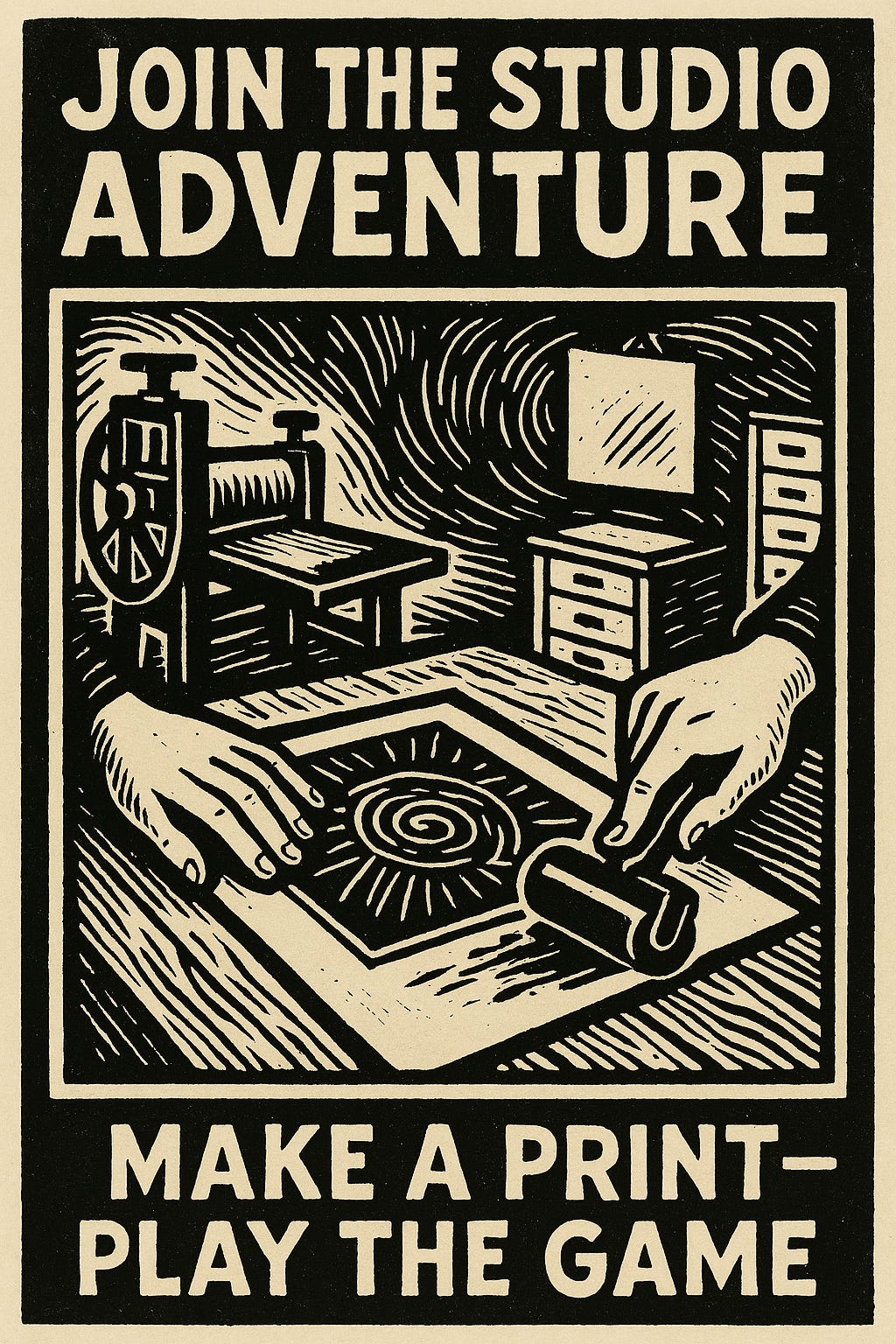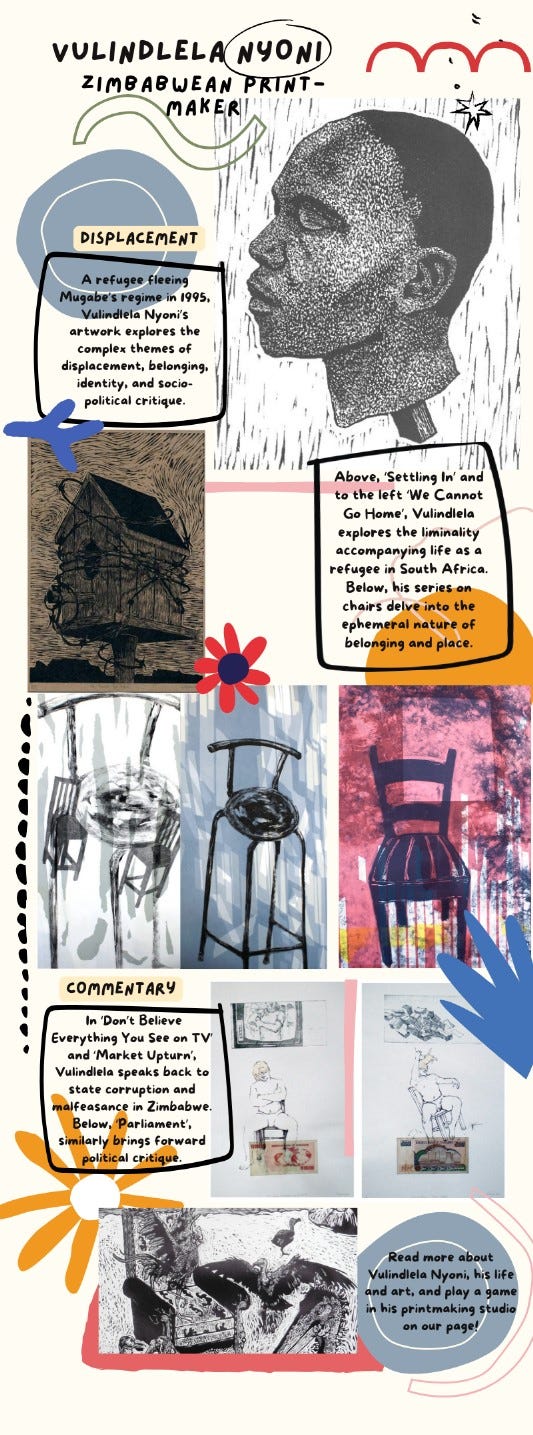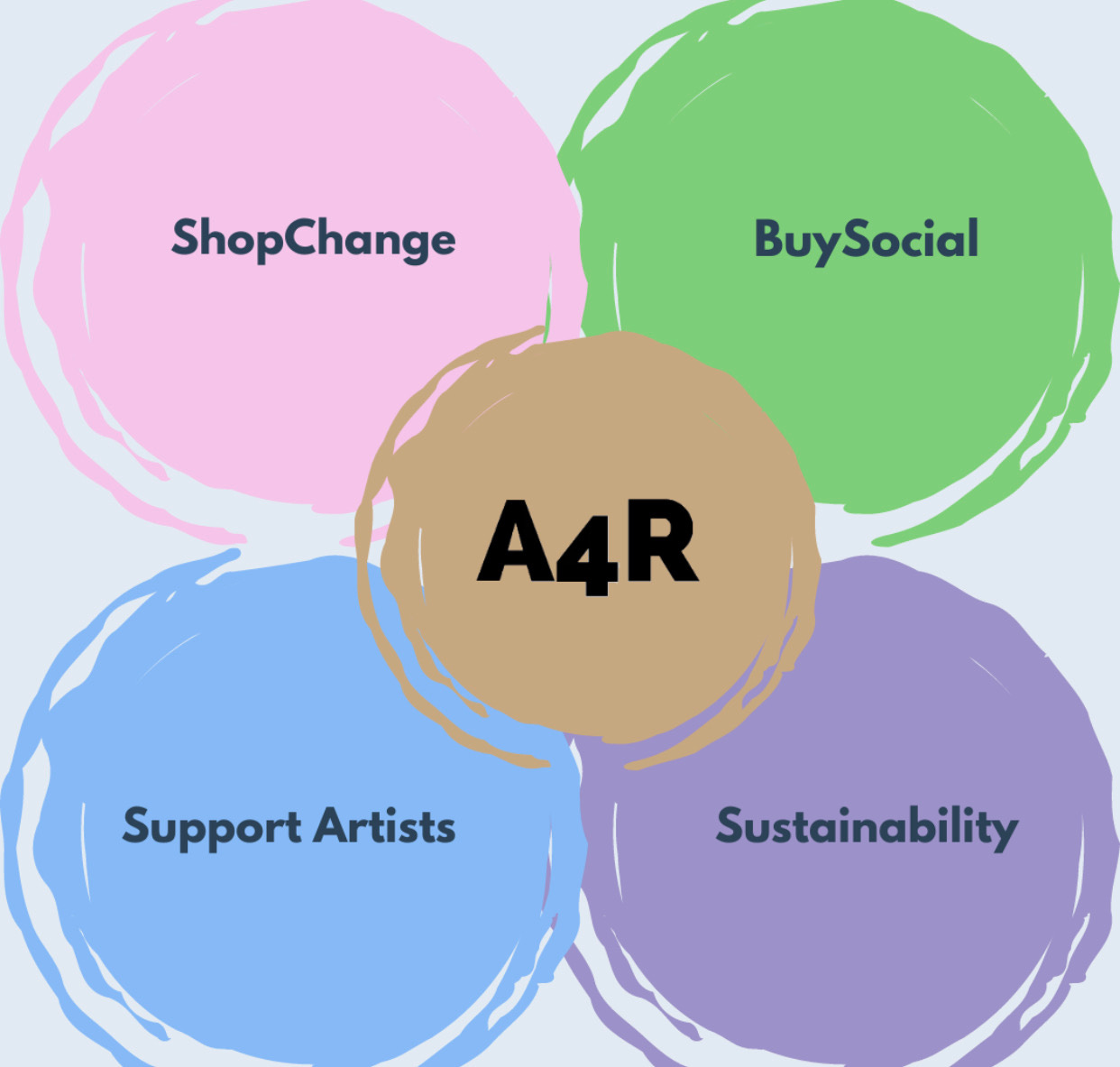Roosters & Rotten Currency: Untethered Self & Suffocated Dreams. He Prints Exile Into Art 🎨🔥
Read, Listen, Play & learn about Vulindlela Nyoni's arty refugee experience 🎮
Click here to play & learn.
Back Story
Home, Displaced: Vulindlela Nyoni's Artwork Bringing Zimbabwean Refugee Realities to Light
‘We cannot go home’. A bird house sits encircled by barbed wire. In the background, the familiar shape of Table Mountain looms - a poignant juxtaposition of shelter and barrier, of new horizons and restricted freedom. A tension engulfs the piece, that of what this house, its wired condition and geographical placement represents. Look deeper and you’ll find the story of a refugee and broader community shaped by displacement, belonging, and reimagining home.
The print 'Settling In' captures a haunting self-portrait: Nyoni's head, untethered from its body, floats in liminal space - capturing the liminal existence of those caught between homes, between places, between identities.
These pieces emerge from Nyoni's personal journey as a Zimbabwean refugee in South Africa. After fleeing instability under Mugabe’s regime in 1995, Nyoni has lived and worked in Pietermaritzburg, becoming a renowned printmaker, art professor and academic. While powerful personal narrative, his pieces also speak to universal themes of dislocation and belonging. “These works are about leaving home and finding new places," he explained to ‘The Witness’, "I have tried to find new ways of showing what space means to me, what place means to me and the thoughts that come to mind when you leave places".
The complexity of this displacement reverberates through Nyoni's recent doctoral work, where he describes his "daily experience is that of an in-between diasporic subjectivity." His art navigates the intersecting challenges of being both Black and foreign in post-apartheid South Africa, while maintaining connections to a Zimbabwe in ongoing conflict. These works embody what he calls "the inner questions of belonging, home and nostalgia that have been such an integral part of my lived reality" (Nyoni 2024:6)." In short, Nyoni focuses on the complex experiences of ‘being’ and existing as a diasporic subject.
Nyoni is an academic, currently finishing his PhD in Visual Art which focuses on collaborative printmaking, has worked as a professor and is currently head of Fine Arts at Nelson Mandela Bay University. Nyoni is a distinguished artist who has showcased his work extensively through various exhibitions at the national level, including his recent solo exhibition titled "ERRANT" held at the GUS Gallery in Stellenbosch, another at ArtSpace Berlin, Germany in 2009, Earthbound at the Printmakers’ Gallery, Arkansas State University in the USA 2009; Settling In at the Tatham Art Gallery in Pietermaritzburg, South Africa, and Transient Likeness at the Tatham Art Gallery. He has also acted as both a national and regional judge for prominent art competitions such as the Sanlam Portrait Award, Absa Atelier, and Sasol New Signatures.
The Zimbabwean Exodus and Realities of Displacement
Picture Zimbabwe in the 1990s: a land beginning to unravel under Robert Mugabe's iron grip. Born in Chirumanzu, Zimbabwe, Nyoni spent his childhood and early adult years across the midlands and capital city, Harare. As his homeland descended into crisis, he sought refuge in South Africa. The Zimbabwe he left behind was a country in conflict - where hyperinflation meant basic groceries could cost millions, where protests filled streets only to be met with state violence, and where unemployment soared past 70% (Amnesty International 1993; Zimbabwe Country Analysis Report 2014). This economic and socio-political instability triggered an exodus as Zimbabweans crossed borders in search of stability and opportunity.
South Africa, directly below Zimbabwe, has become a primary destination for migrants seeking refuge. Yet the promise of sanctuary often collides with harsh realities: widespread unemployment, limited economic opportunities, and a growing undercurrent of hostility toward migrants (see Landau 2008). This antagonism manifests as 'Afrophobia' - a particular strain of xenophobia directed at African migrants - which permeates social, economic, and political spheres (Cirolia, Nyamnjoh & Hall 2021; 2022). Through his artwork, Nyoni grapples with these complex dimensions of displacement, creating pieces that speak not only to his personal journey but also to the collective experience of Zimbabweans carving out lives in South Africa.
Exploring Dislocation, Alienation and a Displaced Sense of ‘Home’
In these two pieces described in the introduction, Nyoni is expressing this experience of displacement. Moving, changing, shifting – these images tie in our understandings of displacement through his own perspective. He describes the work as an expression of flux, of ‘homelessness’ (Nyoni 2018). The birdhouse strangled by wire seeks to bring forward an idea of ‘not being at home’ that is a lived experience of confinement, being restricted and constrained. His head is physically dislocated, unsettled while simultaneously trying to become settled.
His other artworks, such as the series on ‘Ghost Chairs’, similarly expresses feelings of identity and absence through evocative images. The chairs are ‘ghostly’, both there and not, becoming symbols that call attention to the social, historical and emotional landscapes they occupy. His installation of ‘Murmuration’ with hundreds of birds taking flight across dissected pieces of cloth, speaks to narratives of movement and “migration of labour to centres of capital” (Lemu, 2015).
While these pieces emerge from Nyoni's personal experience, they resonate deeply with anyone who has experienced forced migration. Through his careful manipulation of symbols and space, Nyoni creates a visual language that captures the tension between seeking sanctuary and feeling perpetually out of place.
Speaking Back: Critiquing Power through Art
While displacement remains a central theme, Nyoni's work extends beyond personal exodus to offer pointed commentary on Zimbabwe's political landscape. His pieces ‘Don’t Believe Everything You See on TV’, ‘Market Upturn’ and ‘The Honourable Mr M’ present a powerful critique of Zimbabwean leadership and governance: both on the left and right, a central figure sits on a chair, positioned above two now-valueless Zimbabwean dollar. The left figure sits cross-armed beneath a blaring television, while the right-hand figure points towards the upturned bricks scattered above him. The figures wear masks adorned with rooster crests - a deliberate echo of the ZANU-PF rulers - but they are rendered blind. Through this imagery, Nyoni suggests Zimbabwe's leaders have become performative actors, recycling empty rhetoric while remaining wilfully unseeing to the nation's mounting crises suggested by the upturned bricks and foregrounded currency. Nyoni speaks to South African politics, too, his print of overlaid houses on the cover of ‘Quantitative History and Uncharted People: Case Studies from the South African Past’.
This piece exemplifies how Nyoni uses his art not just to document displacement, but to challenge the power structures that create it. His work becomes a form of resistance, speaking truth to power through carefully chosen symbols and compositions that reveal the disconnect between leadership and reality in contemporary Zimbabwe.
Conclusion: Considering Nyoni’s Art
Vulindlela Nyoni’s artwork serves as a poignant reflection on the complex realities of displacement. Drawing from his personal experience as a Zimbabwean refugee in South Africa, his works explore themes of forced movement, alienation, and the search for a sense of "home." Nyoni captures the emotional and psychological turbulence faced by migrants caught between worlds. His art speaks not only to his individual journey but to the broader experiences of those displaced by political, economic, and social turmoil. His work extends beyond personal narrative, critiquing both Zimbabwean and South African political landscapes, using his visual language as a form of resistance to power structures that perpetuate displacement. Through his intricate compositions, Nyoni challenges the status quo, offering a compelling commentary on the broader themes of migration, governance, and social injustice.
Resource List
United Nations Zimbabwe Country Analysis Report 2014.
Landau, L. 2008. Migration in the Southern African Development Community: Zimbabwean Migrants in South Africa. Centre for Migration Studies, University of Witwatersrand, Johannesburg.
Tatham Art Gallery, 2009. People and places. Art: Leaving home and finding new spaces. The Witness. Available online: https://witness.co.za/archive/2009/05/06/people-and-places-20150430/.
Nyamnjoh, H., Hall, S., & Cirolia, L.R. 2022. Precarity, Permits, and Prayers: “Working Practices” of Congolese Asylum-Seeking Women in Cape Town. In Africa Spectrum, 57(1): 30-49.
Nyamnjoh, H., Hall, S. & Cirolia, L.R. 2021. Remittance micro-worlds and migrant infrastructure: Circulations, disruptions, and the movement of money. In Transactions of the Institute of British Geographers, 47(1): 63-76.
Lemu, M. 2015. What lies behind the idea of erring? The Artist as Errant. Available online: https://contemporaryand.com/magazines/vuli-nyoni-the-artist-as-errant/.
In this post Sophia highlights the arty refugee experience of Vulindlela Nyoni. She is a citizen journalist on a placement with us organised by Oxford University Career Services. She also organised the micro game to make the journalistic experience interactive.
Thank you for reading an A4R 🎨 Post. Don’t forget to visit our gift shop here. Every purchase scales our impact and pays our bills.





